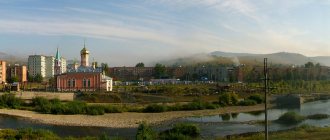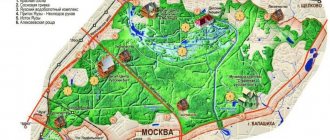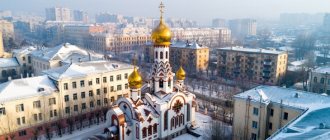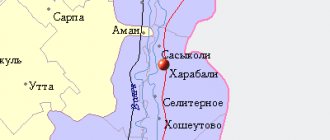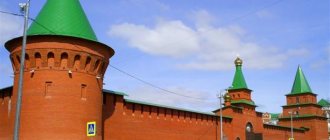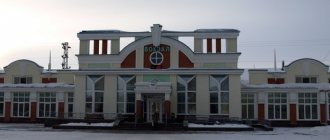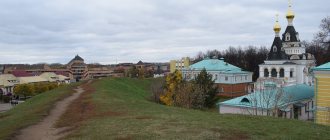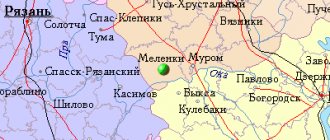The city of Dmitrov is located 65 kilometers from ]Moscow[/anchor], and 50 kilometers from the Moscow Ring Road, north of the capital. It stands on the Yakhroma River and the Canal named after. Moscow. One of the most comfortable cities in Russia. City of Military Glory. Included in the Golden Ring of Russia tourist route. In this article we will get acquainted with the city and its attractions.
Dmitrov history.
Let's start our acquaintance with a little historical background. The city was founded in 1154 by Prince Yuri Dolgoruky in the swampy valley of the Yakhroma River. Named in honor of Vsevolod the Big Nest (baptized Dmitry, son of Yuri Dolgoruky), born that year. The city was conceived as an outpost for the defense of the Vladimir-Suzdal land. Dmitrov was located at the junction of the borders of the Moscow, Tver and Pereslavl principalities. In 1180, during the war between Svyatoslav Vsevolodovich and Vsevolod the Big Nest, Dmitrov was burned. It soon recovered from the ruin and by 1214 it was already a large city with suburbs, and belonged to Yaroslav Vsevolodovich. The city was not spared by the Tatar-Mongols, who burned it about six times.
Dmitrov history.
Dmitrov, during the period of fragmentation of Rus', passed from one prince to another. In 1569, Prince Vladimir Andreevich of Dmitrov was executed, becoming the last appanage prince in Rus', and the city was transferred to the oprichnina. The period from the 16th to the second half of the 17th centuries. Historians associate it with the decline of the city. The situation changed in 1781, when Dmitrov became the center of the county and, among many Russian cities, received a coat of arms. By the end of the 18th century, a new revival in local trade began, which affected the development of Dmitrov. Stone construction was resumed, old wooden churches were rebuilt, and in 1784 the city received a regular development plan.
Dmitrov history.
In the second half of the 19th century, after the construction of the Nikolaevskaya railway Moscow - St. Petersburg through Klin (1851) and the Yaroslavl railway through Sergiev Posad (1869), Dmitrov, while remaining an administrative center, found itself in a relatively disadvantageous economic position. At the beginning of the 20th century, Dmitrov experienced all the hardships of the revolutionary movement. During the period of Soviet power, the construction of the canal to them became key in the history of the city. Moscow. Construction contributed to population growth and industrial development. In the 1960s–1980s, the city was built up with apartment buildings during the period of rapid development of industrial enterprises and acquired the main features of its modern appearance. For the 850th anniversary of the city (2004), a large-scale campaign was carried out to improve and develop the city.
Content
- 1 General description
- 2 History of the city
- 3 Saints
- 4 Monasteries 4.1 Boris and Gleb Monastery
- 5.1 Elizabeth Church (Dmitrov)
- 7.1 Where next from Dmitrov
Dmitrov today.
In 2005, Dmitrov took first place in the All-Russian competition “The most comfortable city in Russia” in the category “Up to 100 thousand inhabitants”. On October 30, 2008, Dmitrov was awarded the honorary title of the Russian Federation “City of Military Glory.” Over the course of more than eight centuries of history, the city has experienced prosperity and decline, wars, revolutions, and despite this, the city has preserved a large number of architectural monuments.
Military units and formations formed from the city population
On June 22, 1941, peaceful life was interrupted by an attack by Nazi Germany. The war aroused a feeling of patriotism among the people, a desire to defend the freedom and independence of the Motherland with all their might. Already in the first month of the war, thousands of our fellow countrymen went to the front voluntarily and through mobilization. In total, during the war, the Dmitrov region sent about 40 thousand soldiers to the front.
On July 3, a volunteer battalion of the people's militia was formed in the number of 922 people, which is part of the volunteer division of the people's militia of the Leningrad district of Moscow. (Commander - reserve captain M.A. Nosevich). At the end of July, in case of a possible occupation, three partisan detachments were formed; bases for them were equipped in the forests north and east of the city and people were trained for underground work.
By the end of August, a Fighter Battalion consisting of 180 people was created to protect enterprises, bridges and other strategically important objects. Captain Dmitry Alekseevich Glebov was appointed battalion commander, and junior reserve lieutenant Petr Alekseevich Berezkin was appointed political instructor. The battalion had five platoons. The city platoon under the command of senior sergeant Semyon Pronin was composed of workers and employees. The battalion's training took place on a trampled meadow, where the Planet cinema is now. At the beginning of the school year, eighth- and ninth-graders from Dmitrov schools were included in the fighter battalion.
Dmitrov Kremlin.
In the very center of the city is the Dmitrov Kremlin, it is surrounded by an earthen rampart that has survived to this day. The architectural dominant of the Kremlin is the Assumption Cathedral, built between 1509 and 1533. Nearby is an administrative complex (offices, service wings, prison), the buildings of which were built at different times from 1810 to 1830. Much later, a prison Elizabethan church in pseudo-Russian style was added to it. Also within the boundaries of the fortifications there is a gymnasium, a noble assembly and a parochial school. Near the passage of the Nikolsky Gate in 1868, at the expense of the townspeople, in commemoration of the miraculous salvation of Alexander II from the assassination attempt on him in 1866, the chapel of St. Alexander Nevsky in the eclectic “Ton” style.
Saints[edit]
Bishop Seraphim Zvezdinsky
Hieromartyr Seraphim Zvezdinsky
From January 1920 to the end of 1922, Seraphim Zvezdinsky served as Bishop of Dmitrovsky.
The saint came from the dynasty of schismatic Bonifatievs. The surname Zvezdinsky was given to his father Ioann Gavrilovich when he joined the Orthodox Edinoverie Church. Having joined Orthodoxy, John became one of the most authoritative priests of this church, saving many lost from the schism by the power of preaching and example.
It was John Zvezdinsky who was commissioned to compose the stichera, canon, troparion and kontakion of St. Seraphim of Sarov for his glorification, which took place in 1903. Venerable himself. Seraphim chose such a creator of prayers for himself, curing his son Nicholas from a fatal illness in January 1902. (Hegumen of the Sarov Hermitage, Hierotheus, presented a portrait of the not yet glorified elder to his grieving father, and after prayers to the elder, the boy was cured in one night.) After the glorification, the monk appeared to Father John and, apparently, revealed the impending tragedy of Russia, which is why the priest constantly cried and said to his sons: “ You will no longer live the way I live.”
Nikolai Ioannovich followed in his father’s footsteps, only further. His spiritual father was St. Alexy Zosimovsky. After graduating from the Moscow Theological Academy, the elder blessed him to become a monk, which was no longer popular at that time. He was tonsured in 1908 with the name Seraphim. In 1914, he became the archimandrite of the Chudovsky Monastery in the Moscow Kremlin and faithfully served in this position until 1918, when the Bolsheviks closed the Kremlin to the people.
The three years that Bishop Seraphim spent in Dmitrov became a holiday for its residents during the plague. According to the testimony of his disciples, the bishop ignited all hearts with his prayer and brought the most unrepentant sinners to repentance and the lost into the bosom of the Church. When he served, the churches were full, and there was a line of mourners outside his house. The bishop served in the Assumption Cathedral, parish churches, Borisoglebsky, Spaso-Vlakhernsky and other monasteries.
After his arrest in December 1922, the bishop faced exile, illness, wanderings, and martyrdom in 1937 in Omsk. And glorification as a holy martyr in 2000.
Monuments to Dmitrov.
Several 19th-century buildings are located southwest of the Kremlin. Among them, the Sukhodayev Hotel (1872) stands out, where the district administration is now located. Behind it, along Sovetskaya Street, is the former Spasskaya Church, rebuilt in Soviet times and now occupied by the services of the Dmitrovsky district administration. There are a large number of monuments in the city. The monument to Yuri Dolgoruky, Boris and Gleb, Cyril and Methodius are the most interesting of them. On the territory of the city there is the Architectural complex of the Boris and Gleb Monastery.
The city of Dmitrov certainly deserves the attention of tourists; all the necessary infrastructure has been created for this. Dmitrov is perfect for a weekend tour. In a couple of days you can explore the main attractions, visit several museums and enjoy the peace and tranquility of the provincial town. We tried to tell you the most interesting things about the beautiful city of Dmitrov, we wish you great travels and positive emotions.
Merits of the city's rear
Like all Soviet people, regardless of nationality, age, social status, Dmitrov residents rose up to fight the enemy. On June 25, a decision was made by the city party committee on the organization of work in wartime conditions. Work on the development of the Yakhroma floodplain, which began in May, had to be stopped. Industrial enterprises began to switch to producing products for the front. Women and schoolchildren, starting in August, built defensive structures: dug trenches. Lines of men and teenagers lined up at the military registration and enlistment offices - volunteers for the front.
In July, a collection point for vehicles for the needs of the army was opened at the Dynamo stadium. The population and organizations were required to hand over everything - from bicycles to cars and tractors. The repair shops at this point were already engaged in August-September in assembling vehicles from spare parts, and later in repairing military equipment.
In August, construction of defensive lines began. Employees, students, and housewives dug endlessly long trenches and anti-tank ditches. They manually dug 3 kilometers of trenches, built 220 pillboxes and bunkers, and dug an anti-tank ditch on the southern outskirts of Dmitrov more than 500 meters long. Every day 800 - 1000 people went out to build defensive lines. The workers of the mechanical shop of the excavator plant, who sat at the levers of multi-bucket machines, provided great assistance in this. Upon completion of the work, the excavators and their drivers were sent to the army personnel units. Some of the workers were sent to the extermination battalion, which was based in the glove factory clubhouse. Despite the difficult situation, the plant did not stop its work for a single day until the end of November 1941.
In August, on Bolnichnaya Street, where the tuberculosis dispensary is now, the city’s first rear hospital was opened. The military sanitary squad was formed from volunteers - medical staff of Dmitrov hospitals and sanatoriums. For the hospital, an old GAZ bus was converted into an ambulance with a suspended stretcher by a team of auto mechanics in the repair workshops and handed over to them. The first wounded began to arrive.
The German planes flying towards Moscow made us feel the approaching front. Nevertheless, the city's institutions and enterprises operate, produce products, and serve the population. The excavator plant switched to the production of ammunition for the front and units for Katyushas, which were delivered from Dmitrov to Moscow by .
